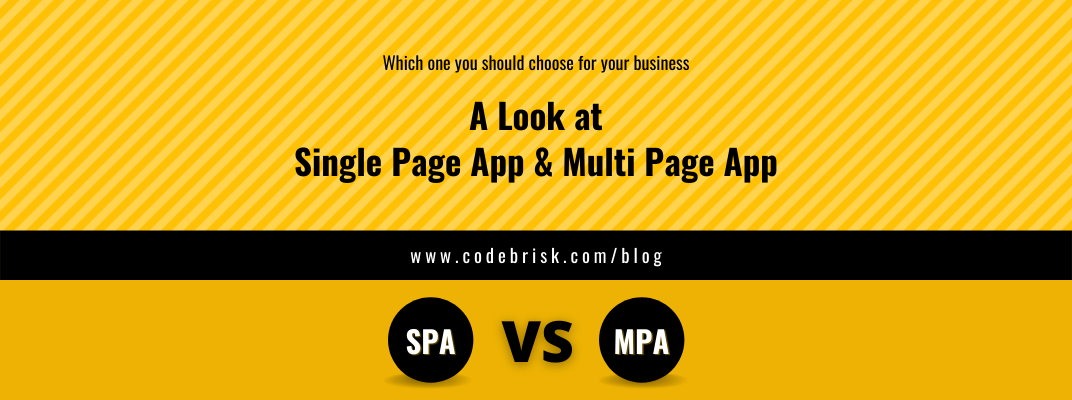Blog Detail
08
Apr
arrow_back A look at Single Page Application Vs Multi Page Application
To guarantee your web app runs without any unwelcome interactions, it has to be supported by the right technology to certify high performance and speed. So if you are hunting for the best technique for creating a website, you’ll definitely encounter two prominent approaches and you will have to pick between MPAs (Multi-page applications) and SPAs (Single-page applications). If you’re skeptical about which one to go with, keep on reading to determine which one is the best choice for your next web application.
What is a Single-Page Application (SPA)?
Single-page applications entitle you to simulate the work of desktop apps. The architecture is organized in such a way that when you go to a new page, only a part of the content is updated. Thus, there is no need to re-download the same elements. This is very convenient for developers and users. The Internet is filled with SPA examples. Some of them you utilize regularly like Netflix, Facebook, Gmail, Google Maps, Trello, Twitter, etc.
Single Page Applications utilize AJAX and HTML5. JS frameworks (React, Angular, Vue, and Ember) are responsible for processing the heavy challenges on the client-side for SPAs. Such apps allow users to stay in one comfy web space and provide them with the best user experience.
Benefits of SPA
Here are the main benefits of the Single Page Application approach.
Speed & Performance: Since SPA doesn’t update the entire page, but only the necessary part, it significantly improves the speed of work.
Quick development: Ready-made libraries and frameworks provide powerful tools for developing web applications. The project can work in parallel with back-end and front-end developers. Thanks to a clear separation they will not interfere with each other.
Mobile applications: SPA allows you to easily develop mobile apps based on the finished code.
Coupling: SPA is strongly decoupled, meaning that the front-end and back-end are separate. Single-page applications use APIs developed by server-side developers to read and display data.
Drawbacks of SPA
Here are some drawbacks of the Single Page Application approach.
Poor SEO: SPA operates based on javascript and it downloads information on request from the client part. Search engines can barely simulate this behavior. Because most of the pages are simply not available for scanning by search bots.
Troubles with security: Spa is more vulnerable to cross-site scripting attacks. Due to XSS, hackers can insert their own client-side script into web apps. However, it can be controlled by the means of securing data endpoints.
What is a Multi-Page Application (MPA)?
An MPA is a web app that includes more than one page and needs to reload the entire page. It is a preferred choice for big companies with large product portfolios, such as e-commerce businesses. If you are looking for examples, just think about Amazon, eBay, Aliexpres, or any other complex site with multiple pages.
Multi-Page Applications operate traditionally. They are quite large out of necessity. MPAs usually consists of a big amount of content so they generally have many levels and various links.
Benefits of MPA
Here are the main benefits of the Multiple Page Application approach.
Easy SEO optimization: MPA allows better website positioning, as each page can be optimized for a different keyword. Also, meta tags can be added on every page which positively affects the Google rankings.
Great Scalability: Mpa offers great scalability. This means that no matter how much content you require your app to include, there will be no limits. MPAs facilitate adding an unlimited number of new features, product pages, information about services, and so on.
Solutions & Frameworks: There are a ton of best practices, approaches, tutorials, and frameworks that assist developers to construct advanced multi-page apps.
Drawbacks of MPA
Here are some drawbacks of the Multi-Page Application approach.
Slow Speed: MPA is slower as the browser must reload the entire page from scratch whenever the user wants to access new data or moves to a different part of the website.
Development time: In multi-page apps the frontend and backend are more tightly coupled, therefore developers need more time to build them. There’s typically one project that requires the frontend and backend code to be written from scratch.
Final Thoughts
Both approaches discussed above have some pros and cons. SPA is characterized by its speed and the ability to develop a mobile application based on ready-made code. But at the same time, SPA has poor SEO optimization. Thus, this architecture is an excellent approach for SaaS platforms, social networks, and closed communities, where search engine optimization does not matter.
MPA offers high performance and better SEO optimization but still does not enable you to easily develop a mobile application.MPA’s are best used in e-commerce apps, business catalogs, and marketplaces. If you’re a large company that offers a wide variety of products, then an MPA is the best choice for you.
Note
Being a custom web development company, Codebrisk has proven experience in developing single-page and multi-page applications for companies of any size and in a variety of industries. At Codebrisk, our expert developers utilize the best techniques for building custom-made web apps. So if you have a great idea, We are here for you to assist with this initiative. Please Feel free to get in touch or start a project with us.
Published at : 08-04-2022
Rizwan Aslam
I am a highly results-driven professional with 12+ years of collective experience in the grounds of web application development especially in laravel, native android application development in java, and desktop application development in the dot net framework. Now managing a team of expert developers at Codebrisk.

Launch project
